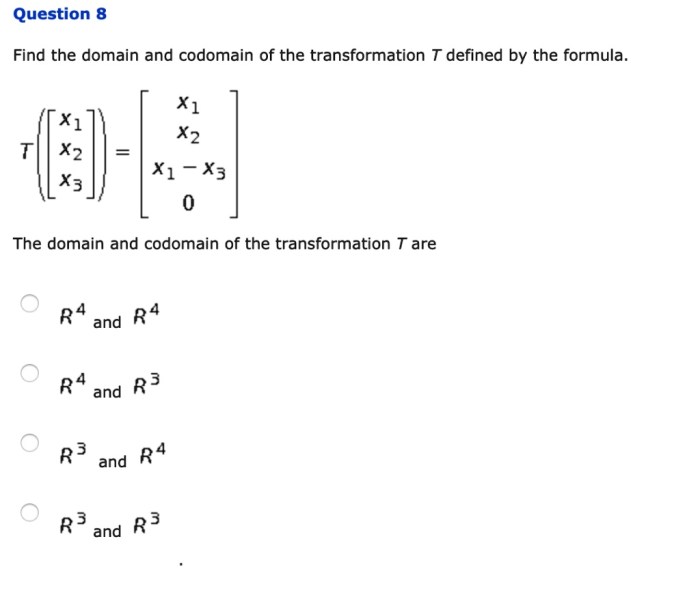The codomain of the transformation x, a fundamental concept in mathematics, plays a pivotal role in defining the range and properties of transformations. This in-depth analysis delves into the intricacies of the codomain, its relationship with the domain, and its significance in various fields, including calculus, computer science, and real-world applications.
The codomain, often denoted as Y, represents the set of all possible output values for a given transformation. It establishes the boundaries within which the transformation operates, influencing the range of values that can be produced.
Definition of Codomain
In the context of transformations, the codomain is the set of all possible output values that can be produced by the transformation. It is the set of values that the transformation can map the input values to.
For example, if the transformation is a function that takes real numbers as input and produces real numbers as output, then the codomain of the transformation is the set of all real numbers.
Types of Codomains
The codomain of a transformation can be any set. However, the most common types of codomains are:
- The set of real numbers
- The set of complex numbers
- The set of vectors
- The set of matrices
Relationship between Domain and Codomain

The domain and codomain of a transformation are closely related. The domain is the set of all possible input values for the transformation, while the codomain is the set of all possible output values. The range of the transformation is the subset of the codomain that is actually reached by the transformation.
In other words, the range is the set of all possible output values that can be obtained by applying the transformation to the elements of the domain.
Determining the Range of a Transformation
The domain and codomain of a transformation determine the range of the transformation. If the domain is restricted, then the range will also be restricted. For example, if the domain of a transformation is the set of all positive integers, then the range will be the set of all positive integers.
However, if the domain of a transformation is the set of all real numbers, then the range can be any subset of the real numbers.
The codomain of a transformation also affects the range. If the codomain is restricted, then the range will be restricted to a subset of the codomain. For example, if the codomain of a transformation is the set of all positive integers, then the range will be a subset of the set of all positive integers.
However, if the codomain of a transformation is the set of all real numbers, then the range can be any subset of the real numbers.
Codomain and Function Notation

The codomain is represented in function notation using the arrow symbol (→). The notation f: A → B indicates that the function f maps elements from the domain A to the codomain B.
Examples
* For the function f(x) = x^2, the domain is the set of all real numbers, and the codomain is also the set of all real numbers, since the function can take any real number as input and produce any real number as output.
This is represented as f: R → R.
For the function g(x) = |x|, the domain is the set of all real numbers, but the codomain is the set of all non-negative real numbers, since the function always produces a non-negative output. This is represented as g
R → R+.
Codomain in Linear Transformations
The codomain of a linear transformation plays a significant role in determining its properties and behavior. In a linear transformation, the codomain represents the set of all possible output values that the transformation can produce.
Relationship between Codomain and Properties of Linear Transformations
The codomain affects the linearity of a transformation. A transformation is linear if it preserves the operations of addition and scalar multiplication. If the codomain is a vector space, then the transformation is linear if it satisfies the following conditions:
- Additive Property:T(u + v) = T(u) + T(v) for all u, v in the domain.
- Scalar Multiplication Property:T(cu) = cT(u) for all u in the domain and c in the field of scalars.
The codomain also affects the injectivity and surjectivity of a transformation. A transformation is injective (one-to-one) if it maps distinct elements in the domain to distinct elements in the codomain. A transformation is surjective (onto) if every element in the codomain is the image of at least one element in the domain.The
relationship between the codomain and the properties of linear transformations can be summarized as follows:
- The codomain determines the linearity of a transformation.
- The codomain affects the injectivity and surjectivity of a transformation.
Understanding the role of the codomain in linear transformations is crucial for analyzing and classifying linear transformations. It provides insights into the behavior and properties of these transformations, which are essential in various mathematical applications.
Codomain in Calculus

The codomain in calculus holds significant importance in understanding the behavior of functions. It provides the range of possible output values for the function, which influences the interpretation of derivatives and integrals.
Derivative and Codomain
The derivative of a function measures the instantaneous rate of change. The codomain of the derivative is the set of real numbers, which represents the possible values of the slope of the function at any given point. The codomain of the derivative can provide insights into the monotonicity, concavity, and extrema of the function.
Integral and Codomain
The integral of a function represents the area under the curve of the function. The codomain of the integral is the set of real numbers, which represents the possible values of the total area between the function and the x-axis.
The codomain of the integral can provide information about the net change of the function over an interval.
Examples
Consider the function f(x) = x^2. The codomain of this function is the set of non-negative real numbers, since the square of any real number is always non-negative. This codomain restricts the possible behavior of the function, ensuring that it is always increasing and never negative.Another
example is the function g(x) = sin(x). The codomain of this function is the interval [-1, 1], as the sine function can only output values between1 and 1. This codomain limits the range of possible oscillations for the function, providing insights into its periodicity and boundedness.
Codomain in Computer Science

In computer science, the codomain of a function or algorithm refers to the set of possible output values that the function or algorithm can produce. It is closely related to the domain, which is the set of possible input values.
The codomain plays a crucial role in determining the efficiency and functionality of algorithms, particularly in data structures and algorithm design.
Codomain in Data Structures, The codomain of the transformation x
In data structures, the codomain of a data structure defines the range of values that can be stored within it. For example, an array with a codomain of integers can only store integer values, while a linked list with a codomain of strings can only store string values.
The codomain of a data structure affects its performance characteristics, such as memory usage and search efficiency.
Codomain in Algorithms
In algorithms, the codomain of an algorithm determines the set of possible output values that the algorithm can produce. The codomain of an algorithm is often specified as part of its formal definition. For example, an algorithm that sorts a list of numbers may have a codomain of sorted lists of numbers.
The codomain of an algorithm affects its correctness, efficiency, and applicability.
Applications of Codomain

The codomain plays a crucial role in various fields, including mathematics, computer science, and engineering. Understanding the codomain of a transformation helps determine the range of possible outputs and provides valuable insights into the behavior of the transformation.
Real-World Applications
- Function Analysis:In mathematics, the codomain of a function determines the set of possible values that the function can output. By examining the codomain, mathematicians can analyze the range and behavior of the function, identifying its maximum, minimum, and other key characteristics.
- Computer Graphics:In computer graphics, the codomain of a transformation matrix defines the range of possible coordinates that a point can be transformed to. This knowledge is essential for manipulating and rendering objects in 3D space, ensuring that they remain within the desired viewing area.
- Linear Algebra:In linear algebra, the codomain of a linear transformation specifies the vector space in which the transformed vectors reside. This information is used to determine the dimension and properties of the transformed subspace.
- Calculus:In calculus, the codomain of a derivative or integral operation defines the set of possible values for the result. By understanding the codomain, analysts can make inferences about the behavior of the function, such as its increasing or decreasing intervals.
- Computer Science:In computer science, the codomain of a data type determines the range of values that can be stored in a variable or data structure. This knowledge is crucial for ensuring data integrity and preventing overflow or underflow errors.
Top FAQs: The Codomain Of The Transformation X
What is the relationship between the domain and codomain of a transformation?
The domain and codomain are interconnected. The domain defines the set of input values, while the codomain defines the set of possible output values. The range of the transformation, which is the subset of the codomain actually produced by the transformation, is determined by both the domain and codomain.
How is the codomain represented in function notation?
In function notation, the codomain is typically represented as the set of values after the arrow. For example, in the function f(x) = x^2, the codomain is the set of real numbers, denoted as R.
What is the significance of the codomain in calculus?
In calculus, the codomain plays a crucial role in determining the behavior of functions. For instance, in the context of derivatives, the codomain indicates the set of possible slopes for the function. Similarly, in integrals, the codomain represents the set of possible areas under the curve.
